The MGA With An Attitude
VELOCITY STACKS #1-- PP-104
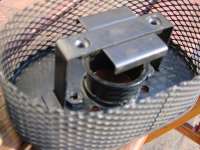 The Velocity stack may be alternately called stub stack, air ram, or ram horn. The factory called it "venturi" when they were incorporated into the air cleaners on the later MGA Twin Cam engines. For most applications the intended purpose is to smooth out the flow of air entering the intake of the carburetor. Reducing turbulence here may result in a small power gain (but not nearly as much as most people might like to imagine). When you see these on a race car, and the horn is more than 2 inches long, it is also being used to tune the length of the intake runner for maximum air ram effect within a specific range of engine speed.
The Velocity stack may be alternately called stub stack, air ram, or ram horn. The factory called it "venturi" when they were incorporated into the air cleaners on the later MGA Twin Cam engines. For most applications the intended purpose is to smooth out the flow of air entering the intake of the carburetor. Reducing turbulence here may result in a small power gain (but not nearly as much as most people might like to imagine). When you see these on a race car, and the horn is more than 2 inches long, it is also being used to tune the length of the intake runner for maximum air ram effect within a specific range of engine speed.
At 14:40:18 UK time 05 September 2005, Carl Heideman of Eclectic Motorworks wrote:
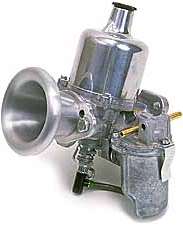
2-inch Air Horn from Moss
|
I've dyno tested stub stacks and velocity stacks for articles in Grassroots Motorsports and Classic Motorsports magazines and can hopefully shed some light on this.
Several companies make velocity stacks, which replace and eliminate the air filters. Most of the manufacturers are copying other products improperly and therefore produce velocity stacks that look cool but don't work. I have only found one good manufacturer, TWM, that makes proper units that do work. Moss, APT, and TWM sell them in two versions, short and long. The long ones give you about 2HP more at the wheels, but won't clear the brake booster on a late MGB. The short ones will, and give you about 1 HP at the wheels. The TWM units are extruded aluminum with a rolled radius around the bell. Cheaper units (that have no effect or cost HP) are stamped with a sharp edge around the bell.
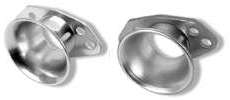
1-inch Stub Stacks from Moss
|
K&N and APT make stub stacks, which fit inside the stock or aftermarket air filters. I've found that they usually give about 1 HP at the wheels--not great, but every HP counts. Additionally, they will give a smoother A/F graph on the dyno, which translates into smoother running on the street. I highly recommend them for any car. -- - Carl
Below is a part from APT (currently $34.89 each) that may work inside a pancake air filter. The key ingredient being the broad radius at the entrance end. The side holes may need to be bored out to fit over the posts inside the MGA air cleaners.
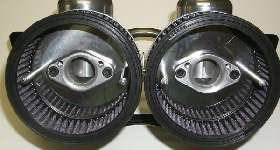
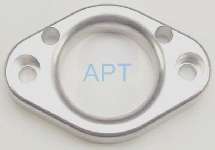
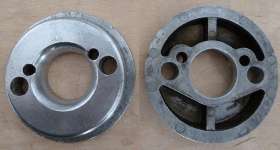 At right is a standard part for 1963-1974 MGB with SU HS-4 carburetors. This has a similar well radiused entry end. From Carl's notes above these might be good for up to 1-HP gain, but I have no dyno test information to prove it. Apparently the MG factory thought it was a worth while part for the money spent in production (and they were pretty stingy with unnecessary parts). When racing folks think $100 per HP is not a bad price for improved performance, these parts can be very appealing. Problem with this particular part is that it is fairly thick and may somewhat obstruct latteral air flow thtough the shallower MGA air cleaner.
At right is a standard part for 1963-1974 MGB with SU HS-4 carburetors. This has a similar well radiused entry end. From Carl's notes above these might be good for up to 1-HP gain, but I have no dyno test information to prove it. Apparently the MG factory thought it was a worth while part for the money spent in production (and they were pretty stingy with unnecessary parts). When racing folks think $100 per HP is not a bad price for improved performance, these parts can be very appealing. Problem with this particular part is that it is fairly thick and may somewhat obstruct latteral air flow thtough the shallower MGA air cleaner.
On 07 August 2011, John Bray in Bedfordshire, UK, wrote:
"I tried my car without filter inserts on the run to Upton House today and the car didn't feel quite as crisp as usual, also the noise of air going through the filter and carburetors was a lot louder without the inserts. As stated above, mine are from the MGB and I believe they were standard fitting on earlier cars". [above right]
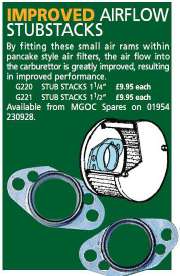 Some of the commercial ads may be appealing, but actual results may not live up to expectations (or advertised gains). The part in the ad to the right may be marginal in actual benefit, if any. Notice the entrance end cut off square with very little radius. See Carl's notes above. The primary appeal here may be the low price, but a bit more money spent on a better part may be more prudent.
Some of the commercial ads may be appealing, but actual results may not live up to expectations (or advertised gains). The part in the ad to the right may be marginal in actual benefit, if any. Notice the entrance end cut off square with very little radius. See Carl's notes above. The primary appeal here may be the low price, but a bit more money spent on a better part may be more prudent.
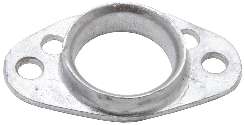 The part at left from K&N may be the same as in the ad at right, but gives a better picture of the entry end.
The part at left from K&N may be the same as in the ad at right, but gives a better picture of the entry end.
Beware that any of these parts may require some fettling to make them fit inside of the stock Volks air cleaners on MGA.
On 07 August 2011, Neil Ferguson in Victoria, Australia, wrote:
"I used the K&N units and they are poorly made and as rough as old boots when they arrived and required a load of mechanical buffing and polishing to get to a reasonable smooth contoured surface and to match the bores".
On 07 August 2011, J.M. Morris in Tennessee, USA, wrote:
"I have the ones from APT for my '74 Midget. When I saw the increase in flow numbers they produced (in a book by David Vizard) I felt they were a very worthwhile investment for such a small price. Rim shape and polish is critical--hence the need for the good ones from APT".
While the velocity stack may seem like a good idea, we obviously cannot put a 2 inch long stack inside of a 2 inch thick air filter housing, as there would be no air inlet space. You may then limit length of the stack to 1 inch maximum to allow some minimal space beyond the end for lateral air inlet flow. If you were thinking about adjusting the length for maximum ram effect, the possible length adjustment range would be minimal (perhaps negligible). So the object then is to do a good job of smoothing the air flow entering the carburetor throat, eliminating the sharp corner at the transition from flat housing base plate into the throat.
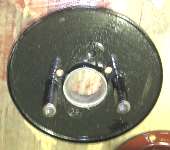 Pictures here show the K&N stub stack installed on the MGA air cleaner back plate. The part is rotated about 90 degrees and is attached with two pop rivets at the extreme ends of the flange. The issues here, as noted on the prior page, are a poor quality part, rough finish, mismatched throat diameter, minimal inlet radius, and sharp cornet at the inlet end. This led to some lively discussion on The MG Enthusiasts' BBS as to what might be an optimal shape for the air inlet. See next page.
Pictures here show the K&N stub stack installed on the MGA air cleaner back plate. The part is rotated about 90 degrees and is attached with two pop rivets at the extreme ends of the flange. The issues here, as noted on the prior page, are a poor quality part, rough finish, mismatched throat diameter, minimal inlet radius, and sharp cornet at the inlet end. This led to some lively discussion on The MG Enthusiasts' BBS as to what might be an optimal shape for the air inlet. See next page.
|








